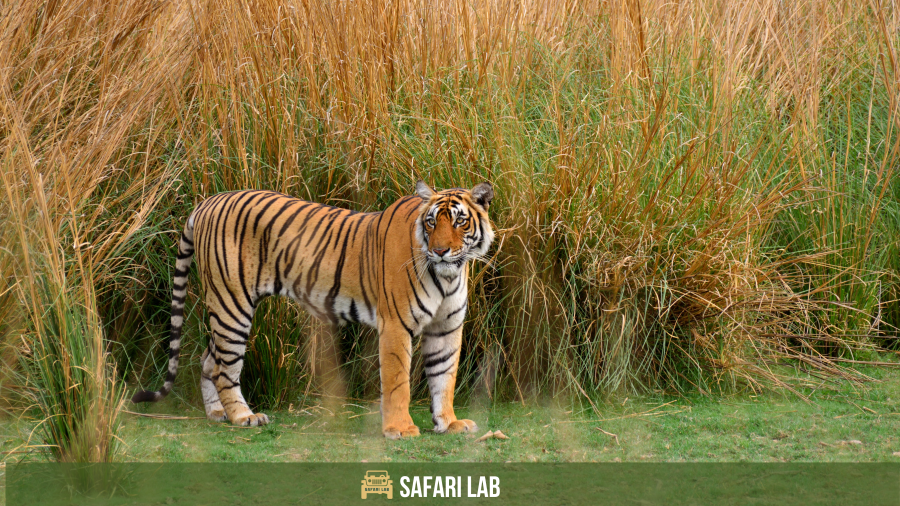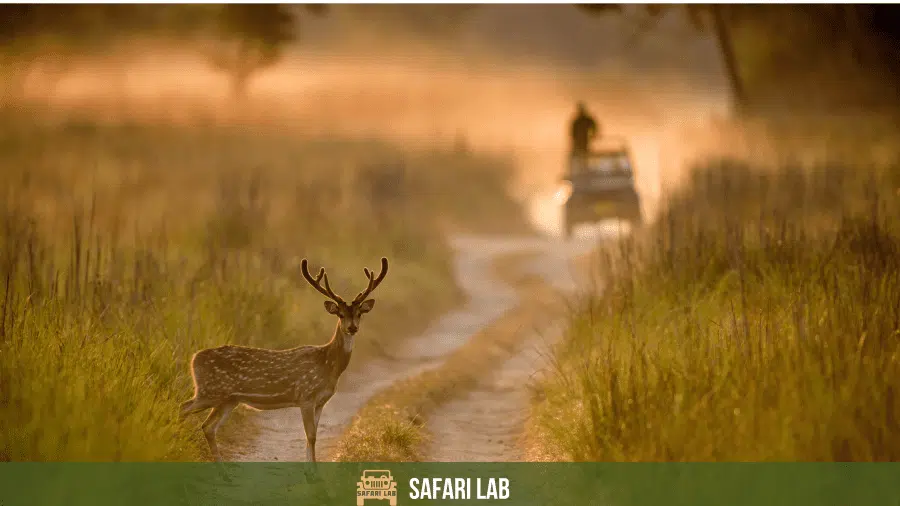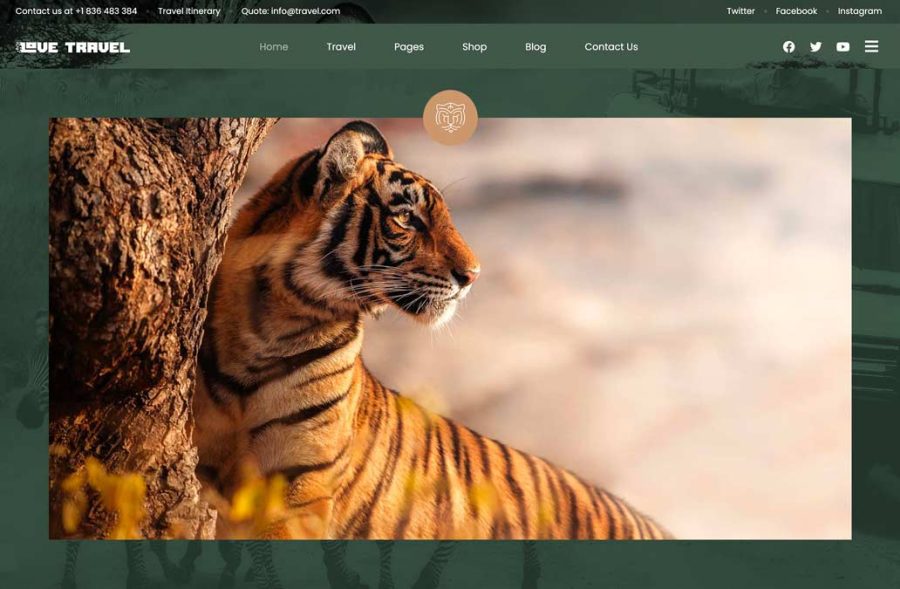Welcome to Ranthambore National Park, a remarkable wildlife sanctuary and tiger reserve situated in the enchanting state of Rajasthan, India. Embark on an unforgettable journey through this biodiverse haven, where the splendor of nature unfolds before your eyes. From thrilling safaris to witnessing majestic Royal Bengal Tigers in their natural habitat, Ranthambore National Park offers a truly remarkable experience for nature enthusiasts and conservationists alike.
Jump To
ToggleKey Takeaways:
- Explore the rich biodiversity of Ranthambore National Park, a wildlife sanctuary and tiger reserve in Rajasthan, India.
- Embark on exhilarating safaris to witness the majestic Royal Bengal Tigers and observe diverse flora and fauna.
- Contribute to the conservation of this natural habitat and support efforts to preserve the park’s biodiversity.
- Discover the unique charm of Rajasthan as you delve into the breathtaking landscapes of Ranthambore National Park.
- Create unforgettable memories in the lap of nature and immerse yourself in the wonders of Ranthambore National Park.
Location and Climate of Ranthambore National Park
Ranthambore National Park, located in Sawai Madhopur, Rajasthan, India, is a paradise for wildlife enthusiasts. Nestled amidst the magnificent Aravali and Vindhya mountain ranges, the park boasts a stunning location that enhances the overall safari experience. This renowned national park spans across an expansive area of 1,334 square kilometers, making it one of the largest wildlife sanctuaries in northern India.
The climate of Ranthambore National Park is diverse and influenced by its geographical location. Summers, from May to June, can be hot and dry, with temperatures ranging from 27 to 41 degrees Celsius. The scorching sun casts a spell over the park during these months, making it slightly challenging for wildlife sightings. However, the striking landscapes and the chance to witness the majestic Royal Bengal Tigers in their natural habitat compensate for the warm weather.
The monsoon season arrives in July and extends till September, bringing relief to the parched land. The park is rejuvenated with lush greenery as the rain showers replenish the water bodies, creating a serene atmosphere. It’s worth noting that the park remains closed to visitors during this period to ensure the safety of both humans and wildlife.
The best time to visit Ranthambore National Park is from November to April, when the weather is mild and comfortable. The winter season, from December to February, offers pleasant temperatures, ranging from 10 to 20 degrees Celsius, making it an ideal time to explore the park. The cool breeze, coupled with the abundance of wildlife, creates a magical experience for visitors.
| Season | Temperature Range | Best Time to Visit |
|---|---|---|
| Summer | 27°C – 41°C | May to June |
| Monsoon | Varies | Park Closed |
| Winter | 10°C – 20°C | November to April |
Flora and Fauna of Ranthambore National Park
Ranthambore National Park, nestled in the heart of Rajasthan, India, is a treasure trove of diverse flora and fauna. The park’s rich biodiversity provides a captivating experience for nature enthusiasts and wildlife lovers alike. Let’s delve into the mesmerizing world of Ranthambore’s flora and fauna.
Flora: A Verdant Tapestry
In Ranthambore National Park, a spectacular variety of more than 300 species of flora thrive. The dominant Dhok tree, covering over 75% of the reserve forest, sets the stage for the park’s vibrant ecosystem. These beautiful trees create a captivating landscape, forming a stunning contrast against the arid surroundings.
Besides the magnificent Dhok, visitors can marvel at the Neem, Banyan, and Pipal trees. The park is also adorned with fruit-bearing trees like the luscious mango and tangy tamarind, adding a delightful touch of color and fragrance to the surroundings.
Fauna: Majestic Beings and Diverse Wildlife
One of the main attractions of Ranthambore National Park is the thrilling opportunity to spot the iconic Royal Bengal Tigers. These majestic creatures, with their striking stripes, roam freely within their natural habitat, captivating visitors with their awe-inspiring presence.
Besides the Bengal Tigers, Ranthambore is also home to other elusive big cats, such as leopards, stealthily traversing the dense jungles. The park’s diversity extends to include unique wildlife species like hyenas and sloth bears, offering a fascinating glimpse into the wonders of nature.
Ranthambore’s avian inhabitants are equally captivating, with a splendid array of 320 species of birds gracing the park. From the elegant Indian peafowl to the magnificent Indian eagle-owl, birdwatchers are sure to be enthralled by the vibrant plumage and melodic calls echoing through the trees.
The park also boasts an impressive reptile population, with 35 species of reptiles, including the Indian python and mugger crocodile. Additionally, a myriad of mammals, such as sambar deer, wild boars, and langurs, add to the park’s thriving ecosystem.
Experience a visual feast for the senses as you witness the breathtaking harmony between flora and fauna in Ranthambore National Park. Immerse yourself in the symphony of nature’s vibrant colors, captivating calls, and the raw beauty of the animal kingdom.
Best Time to Visit Ranthambore National Park
When planning a visit to Ranthambore National Park, it’s important to consider the best time to make the most of your wildlife experience. The park boasts a diverse range of flora and fauna, including the iconic Royal Bengal Tigers. To increase your chances of wildlife sightings and enjoy pleasant weather, it is recommended to visit between October and June.
During this period, the park experiences favorable climatic conditions, making it an ideal time for safari adventures. The temperatures are mild, ranging from comfortable to slightly warm, allowing visitors to explore the park without feeling overwhelmed by extreme heat. Whether you’re an avid wildlife enthusiast or a nature lover, October to June offers optimal conditions for wildlife sightings and outdoor exploration.
Additionally, the period from October to June aligns with the park’s open season, ensuring that all safari zones are accessible to visitors. As the park transitions from monsoon to summer, the landscape flourishes with lush greenery, making it a visually stunning time to witness the vibrant biodiversity that Ranthambore National Park has to offer.
Weather in Ranthambore National Park
The weather in Ranthambore National Park varies throughout the year, and understanding the seasonal climate can help you plan your visit accordingly. Here’s a brief overview of the weather conditions during different months:
October to March: This period marks the winter season, with temperatures ranging from 10 to 25 degrees Celsius. The weather is pleasant and cool, making it an excellent time for wildlife sightings.
April to June: These months constitute the summer season, with temperatures ranging from 25 to 45 degrees Celsius. While the weather can be hot, it offers better opportunities to spot wildlife as animals gather near water bodies.
July to September: Monsoon season brings rainfall to Ranthambore National Park, providing relief from the scorching heat. However, note that the park remains closed during this period to ensure the safety of visitors and wildlife.
Remember to pack suitable clothing and accessories based on the season you plan to visit. Comfortable walking shoes, lightweight clothing, sunscreen, hats, and insect repellent are essential items to carry during your trip to Ranthambore National Park.

Wildlife Sightings
Visiting Ranthambore National Park during the recommended months provides a higher chance of encountering a diverse range of wildlife. Wildlife sightings vary throughout the year, and the best time to spot animals is often during the cooler months when they are more active.
The Royal Bengal Tigers are the park’s most prized residents, and sighting these majestic creatures is a highlight for many visitors. Since the tigers are more active during cooler temperatures, visiting between October and June increases your chances of observing them in their natural habitat.
Other wildlife species that can be spotted in Ranthambore National Park include leopards, hyenas, sloth bears, Indian foxes, sambar deer, chital deer, and various bird species. Exploring the park’s different safari zones enhances your opportunities to witness these incredible creatures up close.
| Wildlife Species | Best Time to Spot |
|---|---|
| Royal Bengal Tigers | October to June |
| Leopards | October to June |
| Hyenas | October to June |
| Sloth Bears | October to June |
| Indian Foxes | October to June |
| Sambar Deer | October to June |
| Chital Deer | October to June |
| Various Bird Species | October to June |
By visiting Ranthambore National Park during the best time, you increase your chances of witnessing the mesmerizing wildlife that inhabits this stunning natural sanctuary.
How to Reach Ranthambore National Park
Travelers can reach Ranthambore National Park through various modes of transportation, ensuring convenient access to this magnificent wildlife sanctuary. Whether you prefer flying, taking the train, or embarking on a road trip, there are options to suit every travel preference.
By Air
The nearest airport to Ranthambore National Park is the Jaipur International Airport, which is well-connected to major cities in India. From the airport, visitors can easily hire a taxi or take a bus to cover the approximately 180-kilometer distance to the park. The journey offers picturesque views of the beautiful Rajasthan landscape, allowing travelers to soak in the natural beauty even before reaching their destination.
By Train
Sawai Madhopur Railway Station serves as the gateway to Ranthambore National Park and is a popular choice for travelers arriving by train. The station has regular train services connecting it to major cities like Jaipur and Delhi. Travelers can easily book their train tickets and enjoy a comfortable and scenic journey to the park.
By Road
If you prefer the freedom of traveling by road, Ranthambore National Park is well-connected through a network of highways. Buses and taxis are readily available from nearby cities and tourist destinations such as Jaipur, Delhi, Udaipur, Mumbai, and Ahmedabad. The road journey allows you to explore the vibrant culture and stunning landscapes of Rajasthan as you make your way to the park.
Once you arrive at Ranthambore National Park, you can immerse yourself in the breathtaking wildlife and natural beauty that awaits. Prepare to embark on an unforgettable safari adventure and witness the wonders of this extraordinary sanctuary.
Safari Options in Ranthambore National Park
When visiting Ranthambore National Park, you have two exciting safari options to choose from: jeep safari and canter safari. Both options offer unique experiences for exploring the park’s breathtaking wildlife and natural beauty.
Jeep Safari: Ideal for small groups, the jeep safari allows for a more personalized and intimate experience. You can get closer to nature, navigate through rugged terrains, and enjoy the flexibility of exploring the park at your own pace.
Canter Safari: If you’re traveling with a larger group, the canter safari is a great choice. This open-air vehicle can accommodate more people, providing an incredible opportunity to bond with fellow nature enthusiasts while immersing yourself in the park’s wonders.
Both safaris are conducted in the morning and afternoon to maximize wildlife sightings and enchanting views. However, please note that the timings may vary depending on the season, so it’s advisable to check the park’s official website for the most up-to-date information on safari timings.
Ranthambore National Park is divided into 10 safari zones, each offering its own distinct wildlife sightings and scenic landscapes. Zones 1 to 5 are particularly renowned for their tiger sightings, making them a must-visit for those eager to catch a glimpse of the majestic Royal Bengal Tigers.
| Safari Option | Park Timings | Safari Zones |
|---|---|---|
| Jeep Safari | Varies based on season | All 10 zones |
| Canter Safari | Varies based on season | All 10 zones |
Immerse yourself in the wilderness of Ranthambore National Park by choosing the safari option that suits you best. Whether you opt for a thrilling jeep safari or a lively canter safari, the park promises an unforgettable adventure filled with spectacular wildlife sightings and awe-inspiring landscapes.
Wildlife Encounters and Attractions in Ranthambore National Park
Ranthambore National Park offers numerous opportunities for wildlife encounters and exploration. Visitors can immerse themselves in the awe-inspiring beauty of nature while experiencing the diversity of wildlife within the park. Here are some of the top attractions:
Ranthambore Fort
Explore the majestic Ranthambore Fort, a UNESCO World Heritage Site, located within the park. This ancient fort provides a unique opportunity to witness history amidst the wilderness. From the top, visitors can enjoy a panoramic view of the park and its breathtaking surroundings.
Lakes
The lakes within Ranthambore National Park are not only a picturesque sight but also serve as a magnet for various animal species. Malik Talao and Padam Talao, among others, attract not only migratory birds but also crocodiles basking in the sun. Take a moment to appreciate the tranquility of these shimmering bodies of water.
Trinetra Ganesh Temple
Nestled within the Ranthambore Fort is the revered Trinetra Ganesh Temple. Dedicated to Lord Ganesha, this temple is a significant religious site visited by many tourists. Seek blessings and immerse yourself in the spiritual ambiance of the temple, offering a moment of serenity amidst the wilderness.
Quote:
“The wildlife encounters and attractions in Ranthambore National Park offer a unique blend of natural beauty, historical significance, and spiritual reverie. It is a place where wilderness and divinity coexist, creating an unforgettable experience for all visitors.”
Wildlife Attractions at Ranthambore National Park
| Attraction | Description |
|---|---|
| Ranthambore Fort | Ancient fort within the park offering panoramic views |
| Lakes | Picturesque bodies of water attracting migratory birds and crocodiles |
| Trinetra Ganesh Temple | A revered religious site nestled within the Ranthambore Fort |
The wildlife encounters and attractions in Ranthambore National Park provide a unique blend of natural beauty, historical significance, and spiritual reverie. Whether exploring the ancient Ranthambore Fort, admiring the serene lakes, or seeking blessings at the Trinetra Ganesh Temple, visitors are sure to be captivated by the charm and enchantment of this extraordinary park.
Iconic Tigers of Ranthambore
Tigers of Ranthambore National Park have attracted considerable attention from wildlife enthusiasts, photographers, and conservationists across the globe due to their charismatic presence and the park’s conservation efforts. In the historical context up to early 2023, a few tigers rose to particular prominence for various reasons such as their unique behaviors, appearances, or the narratives that conservationists, guides, and tourists have crafted around them.
Machali
Machali (also known as T-16), for instance, was one of the most famous tigers of Ranthambore, revered for her strength and dominance over a large territory. She was known as the “Queen of Ranthambore” and became a symbol of Indian wildlife. Her legacy includes a lineage of offspring that continued to inhabit the park, and she lived to a ripe old age by wild tiger standards before she passed away.
Sundari
Her daughter, Sundari (T-17), was also well-known and carried on Machali’s legacy, along with T-19, fondly known as Krishna, who was also a successful tigress in terms of raising cubs.
Ustad
Another illustrious tiger was Ustad (T-24), who was known for his formidable presence and territorial dominance. Ustad became a subject of controversy and debate after being translocated due to allegations of aggression towards humans.
Noor
Tigers such as T-39 (Noor), T-42 (Fateh), and T-85 (Pacman) have also been widely recognizable in the park due to their distinctive stripes, habits, or frequent sightings in tourist-friendly zones of Ranthambore.
These tigers, among others, became the faces of Ranthambore through various mediums like wildlife documentaries, photography, and research studies, contributing significantly to the park’s tourism and conservation narrative.
Best Zones of Ranthambore for Tiger Safari
The best zones for tiger safaris in Ranthambore National Park often depend on recent tiger movements and sightings, but historically, certain zones have been more popular due to their high frequency of tiger activity. Up to 2023, some of the notable zones include:
- Zone 1 to 5: These are often considered the premium zones as many famous tigers like Machali (T-16), Sundari (T-17), and others had territories within these areas. They offer a good chance of spotting tigers, as well as a rich variety of other wildlife.
- Zone 3: This is particularly known for its picturesque landscape including the Padam Talao Lake that attracts tigers and serves as a backdrop for iconic wildlife photographs.
- Zone 4 and Zone 5: These zones are known for their relatively less vehicle traffic compared to Zones 1 to 3, offering a more serene experience while still maintaining good tiger sighting opportunities.
- Zone 6 to 10: While initially added to expand the tourist area and alleviate pressure from the core zones, these have become increasingly popular as tigers have established territories here too. Some visitors have reported great sightings in these areas, although they are sometimes considered secondary to zones 1-5.
Accommodation Options in Ranthambore National Park
When visiting Ranthambore National Park, you’ll find a wide range of accommodation options to suit different preferences and budgets. Whether you’re looking for a luxurious retreat or a more adventurous stay, there are choices that will enhance your experience in this enchanting wilderness.
Luxury Resorts
If you crave a lavish getaway surrounded by nature, Ranthambore National Park offers exquisite luxury resorts. Sher Bagh and The Tiger Roar are two of the top-rated resorts in the area, promising an indulgent stay with world-class amenities and unparalleled hospitality.
| Resort | Facilities | Location |
|---|---|---|
| Sher Bagh | Swimming pool, spa center, fine dining | Adjacent to Ranthambore National Park |
| The Tiger Roar | Infinity pool, wellness center, gourmet cuisine | Near Ranthambore National Park entrance |
Jungle Camps
For the adventurous souls seeking a closer connection with nature, jungle camps provide a unique and immersive experience. The Earth and Jungle Cave Resort are popular options, offering comfortable accommodations amidst the picturesque wilderness.
| Jungle Camp | Features | Location |
|---|---|---|
| The Earth | Tented accommodations, nature walks, bonfire nights | Surrounded by jungle, close to Ranthambore National Park |
| Jungle Cave Resort | Cave-style rooms, wildlife safaris, campfire evenings | Amidst nature, near Ranthambore National Park boundary |
Whether you choose to indulge in luxury or seek an adventurous experience, the accommodation options in Ranthambore National Park are designed to provide comfort and enhance your connection with nature. After a day of thrilling safaris and wildlife encounters, these accommodations ensure you have a peaceful and memorable retreat.
Ticket Prices and Booking Information for Ranthambore National Park
Planning a visit to Ranthambore National Park? Here’s everything you need to know about ticket prices and booking information for an unforgettable safari experience.
Ticket Prices:
If you’re an Indian national, the ticket prices for a Gypsy Safari are 1800 INR per person. For a Canter Safari, the price is 1200 INR per person. For foreign nationals, the ticket prices for a Gypsy Safari are 4200 INR per person, and for a Canter Safari, it’s 3000 INR per person.
It’s important to note that these prices are subject to change, so it’s recommended to check the latest rates before your visit.
Booking Information:
To secure your safari in Ranthambore National Park, it’s advisable to book your tickets in advance. Online booking platforms provide a convenient way to do so, allowing you to select your preferred date, safari type, and zone.
While booking, make sure to provide all the necessary identification details as required. This ensures a smooth entry process and helps adhere to park regulations.
Remember, Ranthambore National Park is a popular destination, so early booking is recommended to secure your spot and avoid any disappointment.
Experience the Wildlife of Ranthambore National Park
Embark on an adventure in the wild and witness the wonders of Ranthambore National Park. Book your tickets in advance and get ready to explore the majestic landscapes, spot incredible wildlife, and create memories that will last a lifetime.
| Safari Type | Indian Nationals | Foreign Nationals |
|---|---|---|
| Gypsy Safari | 1800 INR per person | 4200 INR per person |
| Canter Safari | 1200 INR per person | 3000 INR per person |
Tips and Guidelines for a Successful Safari in Ranthambore National Park
To ensure a memorable and fulfilling safari experience in Ranthambore National Park, it is essential to follow the provided guidelines and tips. Adhering to these recommendations will not only enhance your wildlife encounter but also contribute to the park’s conservation efforts.
1. Follow the Instructions of your Forest Guide
Your assigned forest guide is a knowledgeable expert who will accompany you throughout the safari. It is crucial to listen to their instructions and follow their guidance. They are well-versed in the park’s wildlife behavior, spotting techniques, and safety protocols. By respecting their expertise, you maximize your chances of encountering diverse wildlife species, including the majestic Royal Bengal Tigers.
2. Maintain Silence and Respect the Wildlife
During the safari, maintaining silence is of utmost importance. By minimizing noise and unnecessary movements, you enhance your chances of observing wildlife in their natural habitat. Respecting the tranquil atmosphere allows you to hear the sounds of the wilderness and increases the likelihood of spotting elusive creatures in action. Remember, the park is a designated protected area, and disturbing the wildlife can disrupt their natural behavior. Do check out our blog post on safari etiquettes for more information on this.
3. Dress Appropriately and Blend with the Surroundings
When planning your safari outfit, opt for clothing in earthy tones such as greens, browns, or khakis. These colors help you blend harmoniously with the park’s surroundings and minimize your visual impact on wildlife. Additionally, choose comfortable attire suitable for the prevailing weather conditions, including lightweight and breathable fabrics for hot summers and warmer layers for cooler months.
4. Adhere to Park Regulations and Avoid Littering
Ranthambore National Park has strict regulations in place to ensure the preservation of its delicate ecosystem. Respect these regulations by refraining from straying off designated paths, feeding the wildlife, or collecting any natural artifacts. Littering is strictly prohibited, and it is crucial to carry any trash back with you to maintain the park’s cleanliness and protect the wildlife from potential harm.
5. Carry a Valid Identification Proof
It is advisable to carry a valid identification proof, such as a passport or driver’s license, while visiting Ranthambore National Park. This identification may be requested during ticket verification or park entry. Ensure you keep it safely with you to avoid any inconvenience or delays.
6. Make Advance Bookings for Safari Tours
To secure your safari experience, it is recommended to make advance bookings for safari tours. Ranthambore National Park experiences high demand, especially during peak tourist seasons, and availability may be limited. Booking in advance allows you to choose your preferred safari timings, select specific zones, and avoid potential disappointment due to unavailability.
By following these tips and guidelines, you ensure a fulfilling and responsible safari experience in Ranthambore National Park. Embrace the park’s natural beauty, respect its inhabitants, and contribute towards their conservation.

Conclusion
In conclusion, Ranthambore National Park is a captivating wildlife sanctuary that offers unforgettable safari experiences and a deep connection with nature. The park’s diverse range of flora and fauna, including the majestic Royal Bengal Tigers, provides visitors with a unique opportunity to witness the beauty of wildlife in their natural habitat. Moreover, Ranthambore National Park’s commitment to nature conservation is evident through their efforts to preserve this precious ecosystem.
By adhering to the guidelines set by the forest department and making the most of the safari options available, visitors can create cherished memories while contributing to the conservation of Ranthambore National Park. It is essential to respect the park regulations, maintain silence during the safari, and wear appropriate clothing to blend with the surroundings. These simple steps help ensure the well-being of the wildlife and preserve the park’s natural charm.
Whether you are an avid nature enthusiast or a wildlife lover, a visit to Ranthambore National Park will undoubtedly leave you in awe of the park’s biodiversity and its dedication to nature conservation. So, plan your trip, embark on an adventure, and immerse yourself in the breathtaking beauty of this wildlife sanctuary.
FAQ
What is Ranthambore National Park?
Ranthambore National Park is a renowned wildlife sanctuary and tiger reserve located in Rajasthan, India. It provides a natural habitat for diverse flora and fauna, including the iconic Royal Bengal Tigers.
Where is Ranthambore National Park situated?
Ranthambore National Park is located in Sawai Madhopur, Rajasthan, India.
What is the best time to visit Ranthambore National Park?
The best time to visit Ranthambore National Park is from October to June, when the weather is pleasant, and wildlife sightings are more common.
How can I reach Ranthambore National Park?
Travelers can reach Ranthambore National Park by air through Jaipur International Airport or by train via Sawai Madhopur Railway Station. Road transportation options such as buses and taxis are also available.
What safari options are available in Ranthambore National Park?
Ranthambore National Park offers jeep safari and canter safari options. Jeep safaris are ideal for small groups, while canter safaris can accommodate larger groups.
What are the popular attractions in Ranthambore National Park?
Visitors can explore the iconic Ranthambore Fort, enjoy the beauty of the lakes within the park, and visit the Trinetra Ganesh Temple located within the fort.
What are the accommodation options in Ranthambore National Park?
Ranthambore National Park offers a range of accommodation options, including luxury resorts like Sher Bagh and The Tiger Roar, as well as jungle camps like The Earth and Jungle Cave Resort.
What are the ticket prices and booking information for Ranthambore National Park?
The ticket prices for safaris in Ranthambore National Park vary based on the type of safari and the visitor’s nationality. It is advisable to book safaris in advance through online booking platforms.
Are there any guidelines for visiting Ranthambore National Park?
Yes, visitors should adhere to the guidelines provided by the forest department, follow the instructions of their assigned forest guide, and respect the park regulations to ensure a successful safari experience.
What can I expect to see in Ranthambore National Park?
Ranthambore National Park offers a rich biodiversity, including the majestic Royal Bengal Tigers, leopards, hyenas, sloth bears, a variety of birds, reptiles, and mammals.
How does Ranthambore National Park contribute to nature conservation?
Ranthambore National Park plays a vital role in the conservation of wildlife and their natural habitat. The park’s efforts and conservation initiatives contribute to the preservation of biodiversity and the protection of endangered species, such as the Royal Bengal Tigers.
Recent Posts
Archives
Categories
Customized Trip Form
Author

Sanjay Nair is a multi-award-winning wildlife photographer, conservation storyteller, and co-founder of Safari Lab. With over 15 years of fieldwork and a Nature in Focus award under his belt, Sanjay’s photographs and stories have been published in global outlets such as The Times & The Guardian.
View all posts


























